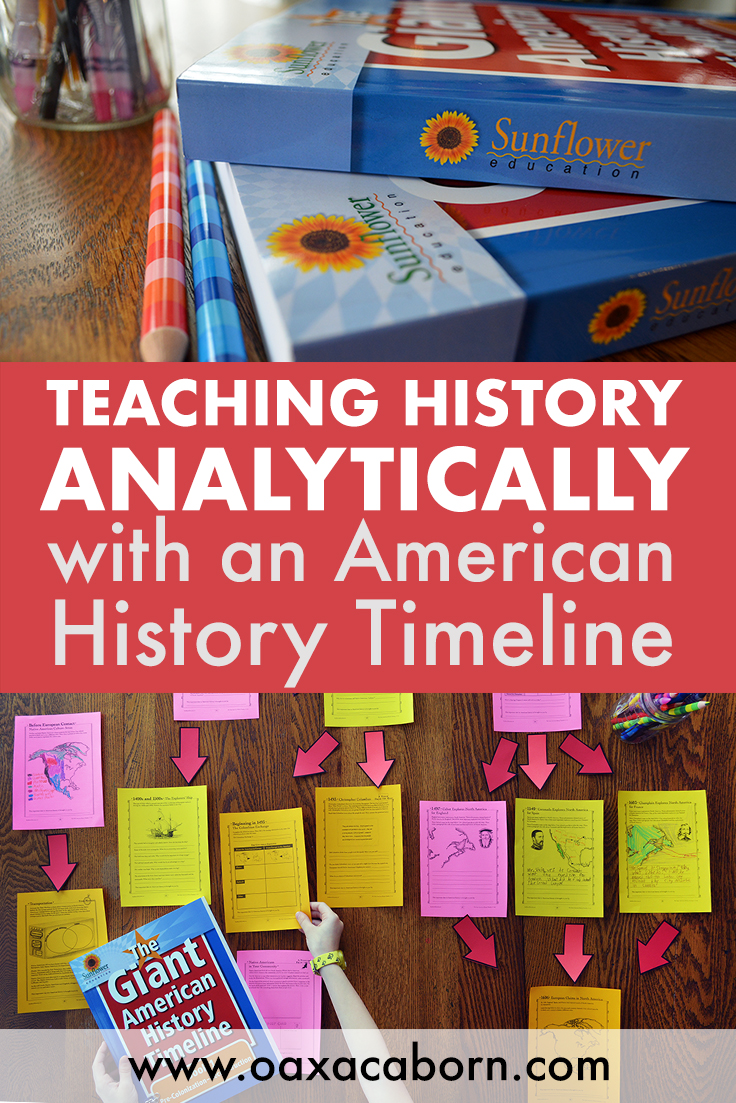 I’m on a perpetual quest to find accurate US history curriculums for kids — but you already knew this about me, right? Compared to objective subjects like math and science, I find history to be particularly challenging to teach properly. While it’s easy for me to seek out the right curriculum — or YouTube video — to help me explain a mathematical concept, it’s much more difficult to offer an accurate commentary on historical events and indeed, people’s own lives.
I’m on a perpetual quest to find accurate US history curriculums for kids — but you already knew this about me, right? Compared to objective subjects like math and science, I find history to be particularly challenging to teach properly. While it’s easy for me to seek out the right curriculum — or YouTube video — to help me explain a mathematical concept, it’s much more difficult to offer an accurate commentary on historical events and indeed, people’s own lives.
History is a complex tapestry. There are threads of war, famine, discovery, and conquest, all woven together with the threads of individual people. But people’s lives are complicated. Too many history curriculums offer snap judgments — telling students exactly what to think — but there’s always more to understand. Biographies are an important key in unraveling historical mystery, because they reveal context, cultural backdrop, and personal motivations. Yet no matter how many rich, enlightening biographies we read, history remains a sequential course of study. Years are chronological. To tie all these separate events and people together and deepen our understanding of what really happened — and how all these different parts are connected — we need to lay out these puzzle pieces in a logical, sequential, pattern.
Disclosure of Material Connection: I received free digital and print copies of The Giant American History Timeline from Sunflower Education, and was compensated for my time in exchange for writing and publishing this post. All opinions are my own, and I was not required to write a positive review.
[We are a participant in the Amazon Services LLC Associates Program, an affiliate advertising program designed to provide a means for us to earn fees by linking to Amazon.com and affiliated sites.
As an Amazon Associate I earn from qualifying purchases.]

Using an American History Timeline to Complement the Logic Stage of Classical Education
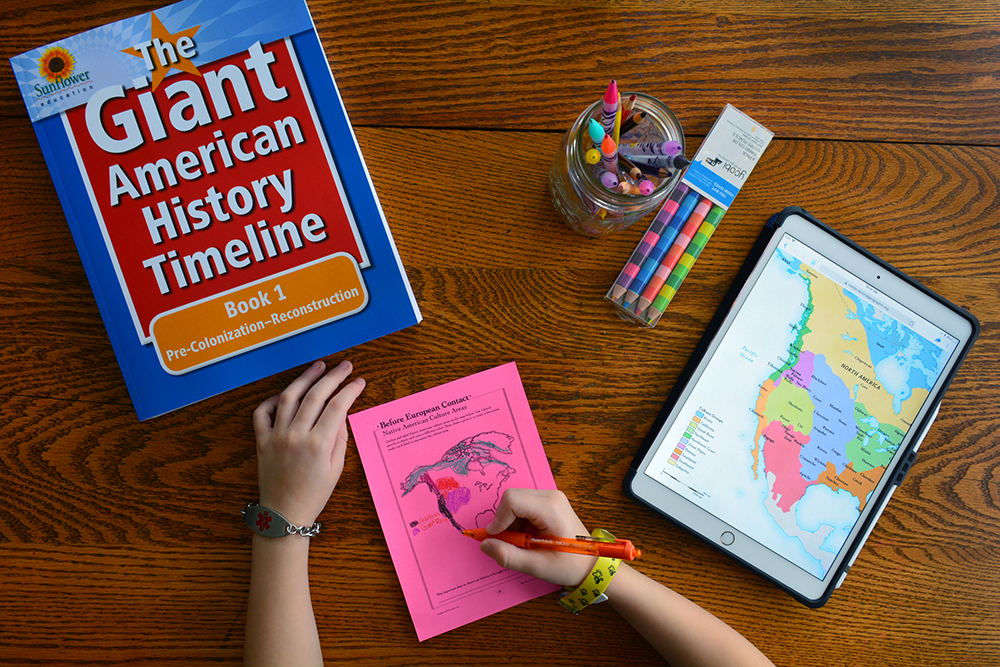
Sequencing is an especially crucial aspect when moving away from lower primary grades and shifting to the upper elementary and middle school years. Around fifth grade, students entering the logic or dialectic stage of classical education are ready to tackle cause and effect, and analyze how topics and events are related. They’ve already spent a great deal of time taking in information; now, they are transitioning into a phase where they’ll begin to link all the pieces together.
One product which handles this middle school logic stage very well is The Giant American History Timeline from Sunflower Education. In the logic stage, just as in The Giant American History Timeline, students don’t simply read about history or about the ways historical figures viewed the world; they instead learn to
- research,
- discover, and
- articulate the domino effect of separate events in history.
We’re not officially in the logic stage, of course, but given the deep questioning in every other area of educating this intense, quirky, gifted kiddo, we do foray into logic stage materials throughout our homeschool weeks.
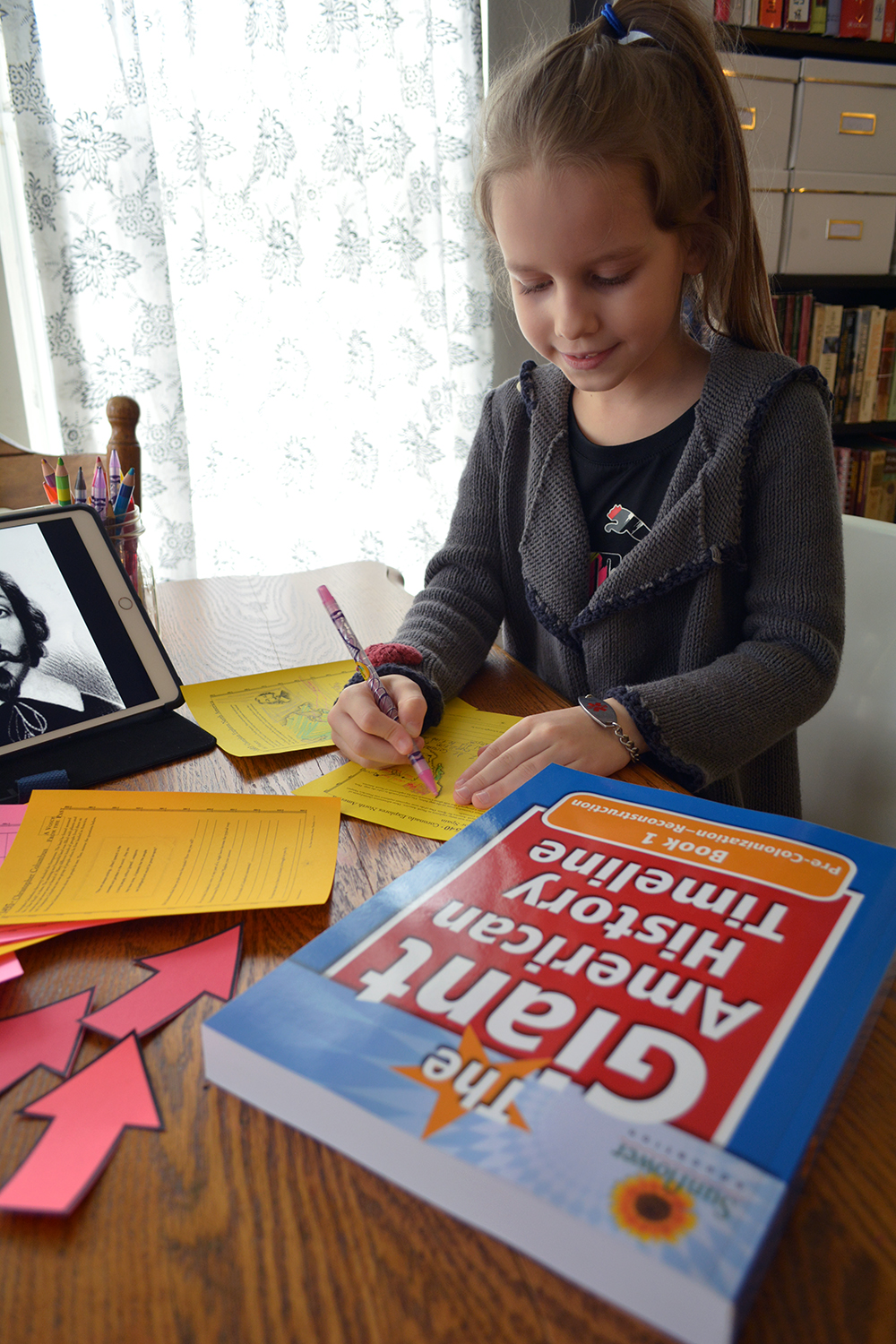
Despite the name — The Giant American History Timeline — this approach is not a linear timeline in which you’ll set up a list of dates and assign events and people to various points in time. It’s a means to create visual, research-based projects. These huge books are broken up into chronologically-progressing themed units containing
- mapping activities,
- dated timeline sheets,
- narrative prompts,
- quotes from source documents,
- and more.
There are two different books, available in print or digital formats:
- The Giant American History Timeline Book 1 (Pre-Colonization to Reconstruction; printed book or digital ebook)
- The Giant American History Timeline Book 2 (1870s to Present; printed book or digital ebook)
The two books are also available for a discounted price if you buy the digital versions as a bundle:
- The Giant American History Timeline Books 1 and 2 Digital Bundle (Pre-Colonization to Present)
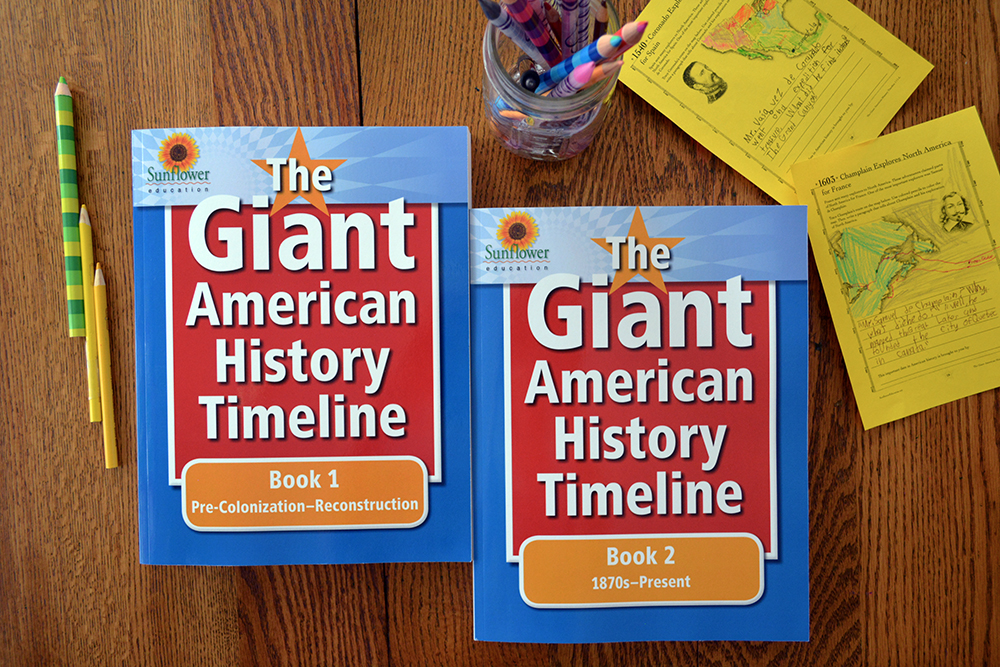
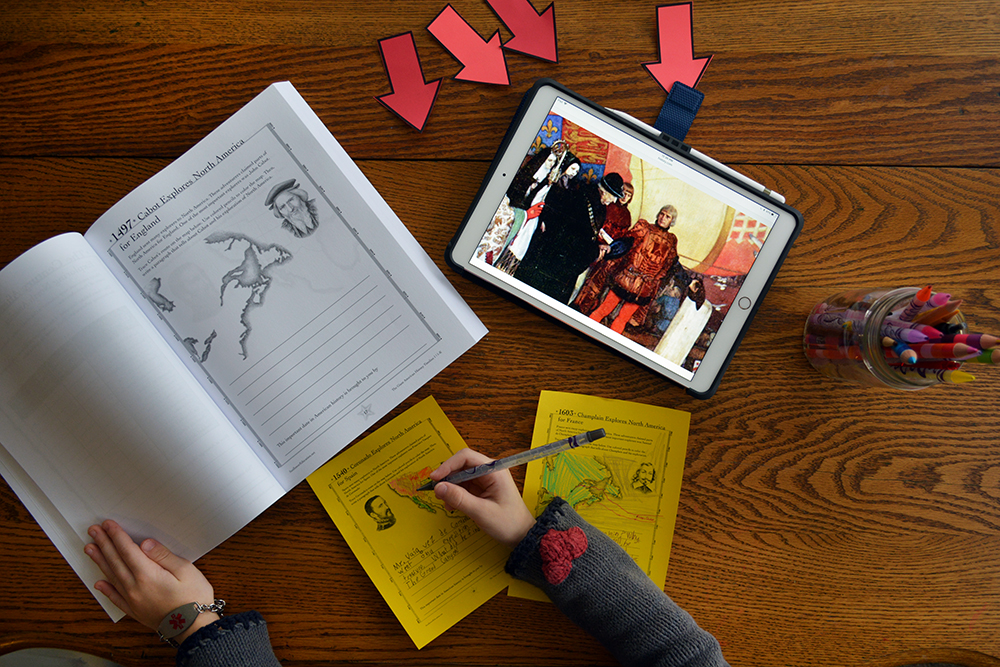 At first glance you might expect simply work through the book page by page, moving on once each page is completed. However, each unit is actually a thorough exercise in interactive critical thinking. You’ll remove the pages from the book — or, if you have the digital version, print the pages — and then work on a large surface such a big table, the floor, or a blank wall.
At first glance you might expect simply work through the book page by page, moving on once each page is completed. However, each unit is actually a thorough exercise in interactive critical thinking. You’ll remove the pages from the book — or, if you have the digital version, print the pages — and then work on a large surface such a big table, the floor, or a blank wall.
In interest of space, we chose to print pages half-size, setting the printer to print two timeline pages on each 8.5×11″ piece of paper. (We love adding splashes of color to our homeschool with our favorite Astrobrights paper!)
Each page requires thought, research, and critical thinking skills. While answers are provided for the parent (there’s a full key in the back), the answers aren’t immediately apparent to the student. I love that! (If you’re looking for a workbook-based approached in which the student reads facts, then repeats those same facts onto worksheets, this isn’t it.)
For each unit, the student will
- research the assigned topics,
- complete the assignments on each page, then
- identify the correct timeline sequence for each page, using the provided date cards.
Once all the pages in a given unit are completed (or at least begun) the student will work on a large open area, and will continue the critical thinking process to
- find connections between events and people,
- identify cause and effect relationships, and
- uncover details of main events.

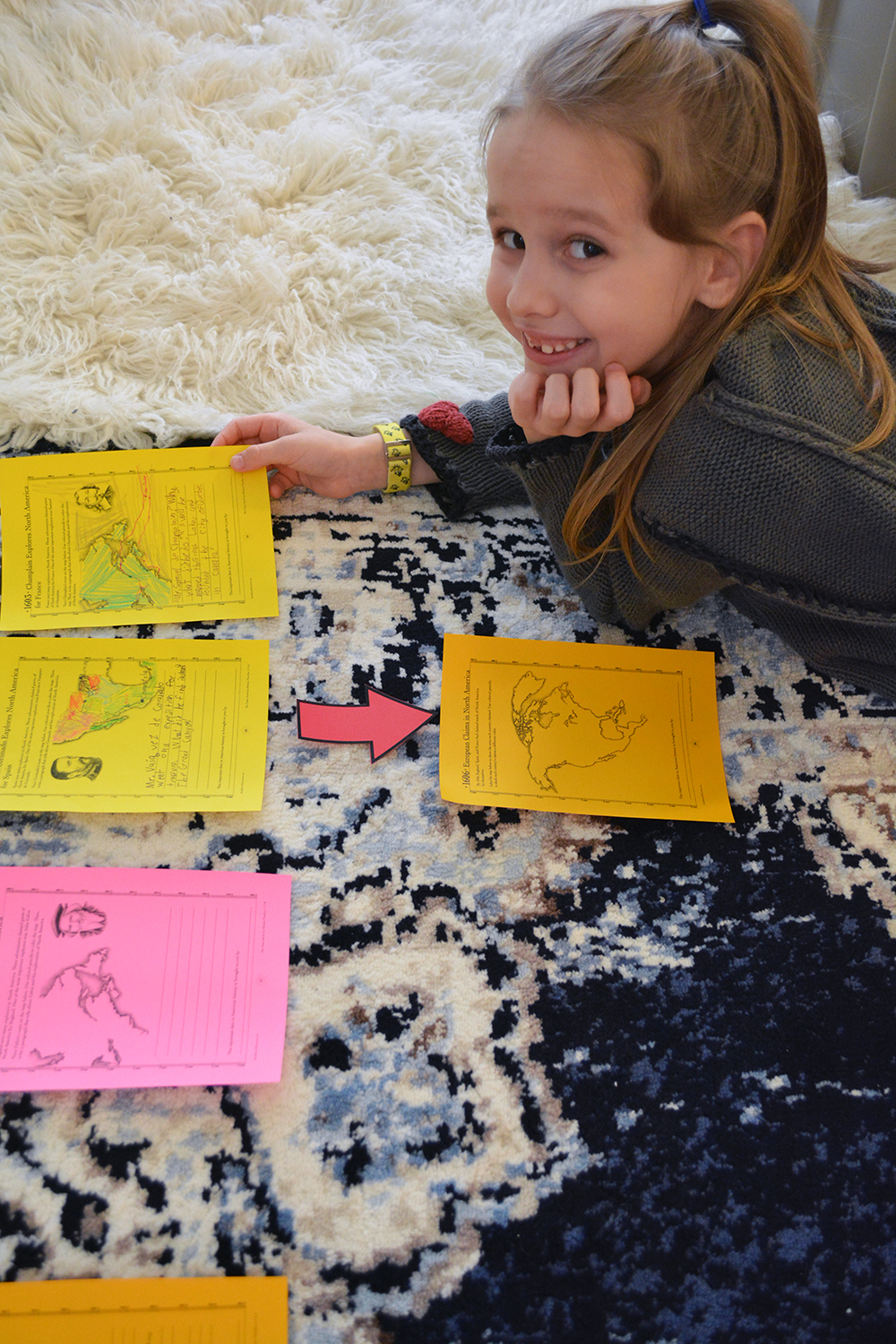
This aspect of the curriculum is so powerful! I love how The Giant American History Timeline teaches kids to think through history in a sequential and methodical way. (Notice I said “think through history”. This thoughtful, logic-stage approach is much different than the memorization and fact-collecting which takes place in the lower-level grammar stage.)
Learning how various historical events and figures are connected opens our eyes to even more connecting pieces. Once this wonderful process of cause and effect is set into motion, there’s really no end to the number of observations we can make. While biographies enable history to become personal, sequencing and cause and effect helps history make sense.
The Giant American History Timeline makes sense of history.
Using an American History Timeline to Tackle Controversial Issues through Source Documents
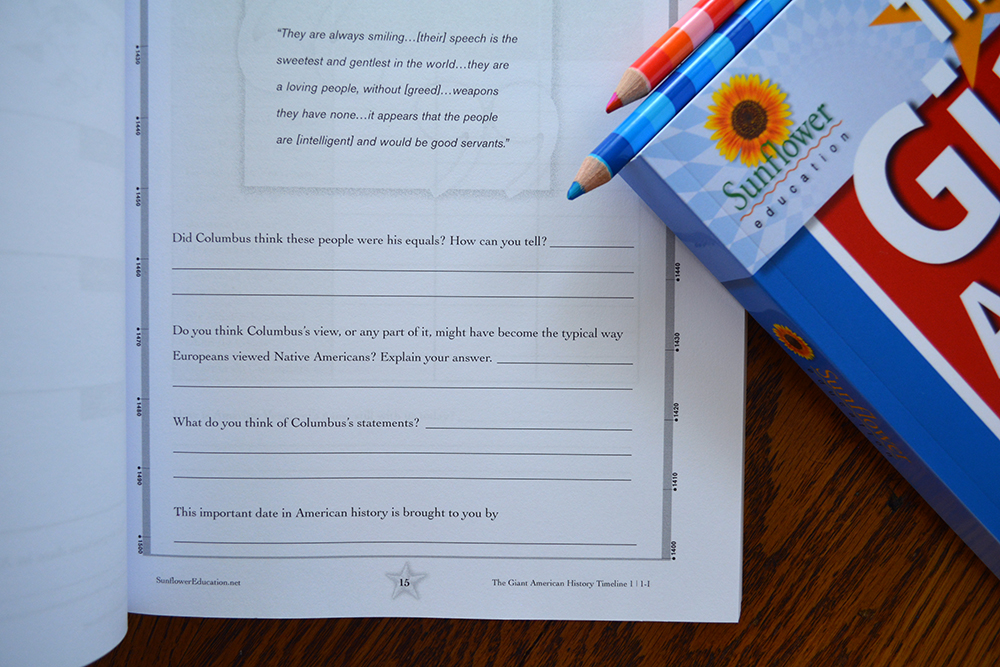
Of course, history isn’t always always easy-to-understand. Some methods of teaching history water down the past and sanitize the rough patches. Other methods include source documents, but then tell the student exactly how to interpret what they’ve just read. In Sunflower Education’s Giant American History Timeline, there’s no easy way around source documents. Students can’t simply skim the quoted passages and quickly answer comprehension questions. Instead, each student is asked to stop and think critically about each passage. In approaching historical documents in this thoughtful way, students will
- learn to uncover how leaders’ individual worldviews impacted historical decisions, and
- learn how those beliefs impact our own biases about history, too.
This fosters both critical thinking skills and discernment, as well as deepening an understanding of how the world works.
Using an American History Timeline to Help Gifted Kids Dive Deeper
If you have a very motivated gifted child — not all gifted kids have the same level of drive — you know what it feels like to fly through printed curriculum like forests are going out of style. (In the Stapled to a Cheetah episode of the Raising Lifelong Learners podcast with Colleen Kessler, I talk about the semester my daughter completed three science curriculums between August and December.) It’s not unusual for my daughter to choose an elementary history textbook as for-pleasure reading, then finish the entire book in mere days.

While Sunflower Education doesn’t market The Giant American History Timeline as gifted curriculum, per se, the nature of the approach —
- deep research,
- critical thinking, and
- hands-on manipulation of the timeline displays
— makes it ideal for the academically gifted child.
The Giant American History Timeline allows academically-gifted kids to —
- approach a topic more deeply than reading through a textbook at a highly accelerated pace can offer
- be challenged by answering open-ended questions, not reciting answers to overly-obvious questions
- practice making inferences,
- identify cause and effect
- research extensively, and
- apply findings logically.
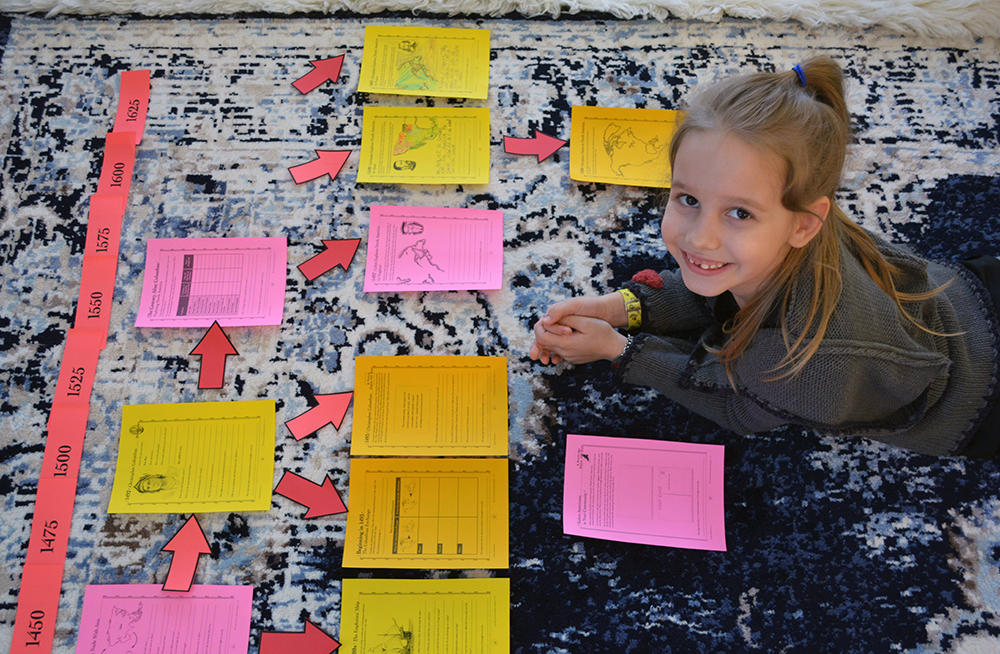
Resources like this, which encourage accelerated learners to learn more deeply, rather than simply more quickly, are a treasured find. The Giant American History Timeline isn’t a curriculum your child will fly through. The thoughtful approach makes it a great way to challenge upper elementary students to engage in meaningful ways, and I so appreciate that.
In fact, it’s challenging enough that even through we’re working through various levels of curriculum designed for students as old as fifth grade, this is still significantly more advanced than any of what we’re using this year. Because of the heavy emphasis on determining cause and effect and analyzing relationships between events, I can see it still challenging her several years from now. It’s truly geared toward upper elementary and middle-school students.
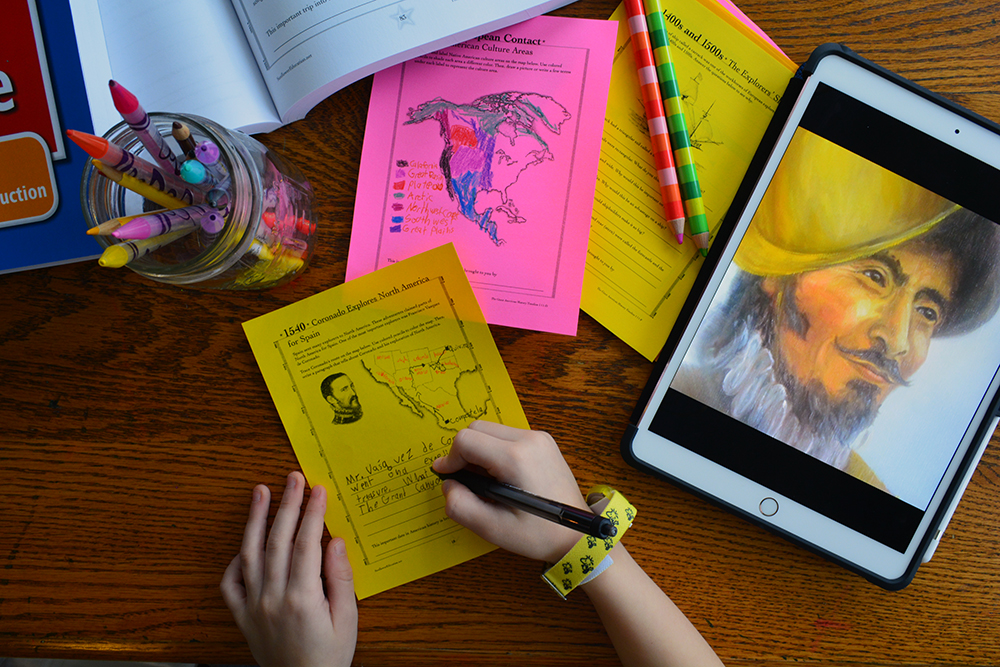
Where to buy Sunflower Education’s Giant American History Timeline Books
The printed versions of The Giant American History Timeline can be purchased on Amazon, while the digital ebooks are available directly from Sunflower Education. While the digital versions make it easy to print the pages you want to use, the printed books are incredibly simple to use as well. Since each consumable page is only printed on one side; just remove from the book and you’re ready to go!
- The Giant American History Timeline Book 1 (Pre-Colonization to Reconstruction; printed book or digital ebook)
- The Giant American History Timeline Book 2 (1870s to Present; printed book or digital ebook)
- The Giant American History Timeline Books 1 and 2 Digital Bundle (Pre-Colonization to Present)
P.S. Use coupon code TIMELINE20 to receive an extra 20% off the already-discounted digital bundle.
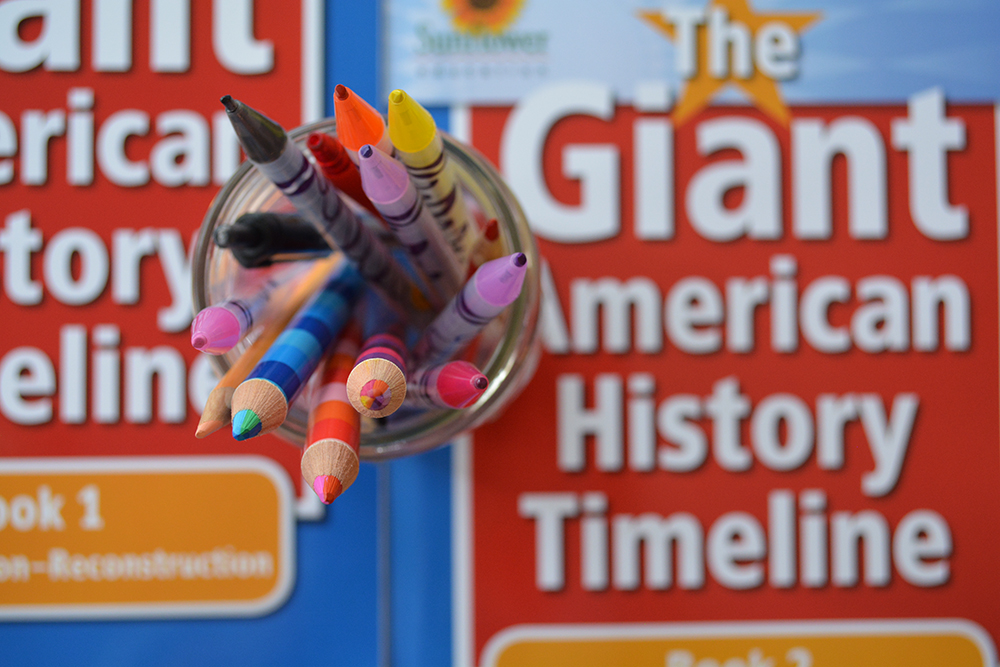
GIVEAWAY: Win a copy of The Giant American History Timeline Book 1
Want a chance to win book one of The Giant American History Timeline? Click on the image below to be taken to the giveaway form, and enter to win. (This sweepstakes is open to U.S. residents age 18 and over, and is operated by Sunflower Education. You are providing your email address to Sunflower Education, not to me.) You’re also welcome to keep up with Sunflower Education on Facebook, follow @sunfloweredtx on Twitter, or be inspired by Sunflower Education on Pinterest, although the only way to actually enter the giveaway is to click through the image below and fill in your name and email address on the resulting page. Giveaway ends on February 7th at 3PM Eastern time.
GIVEAWAY HAS CLOSED
The Giant American History Timeline books from Sunflower Education are a great addition to your homeschool. They integrate so many subjects beyond history, including
- geography, mapping, and map studies,
- literature, historical fiction and biographies,
- the research process,
- vocabulary and reading comprehension,
- writing and narration,
- speeches, presentations, and
- much, much more.
Definitely worth adding to your home library!
—
If you found this homeschool curriculum review helpful, why not click here to get this post’s Permalink, then pin it to Pinterest? :)


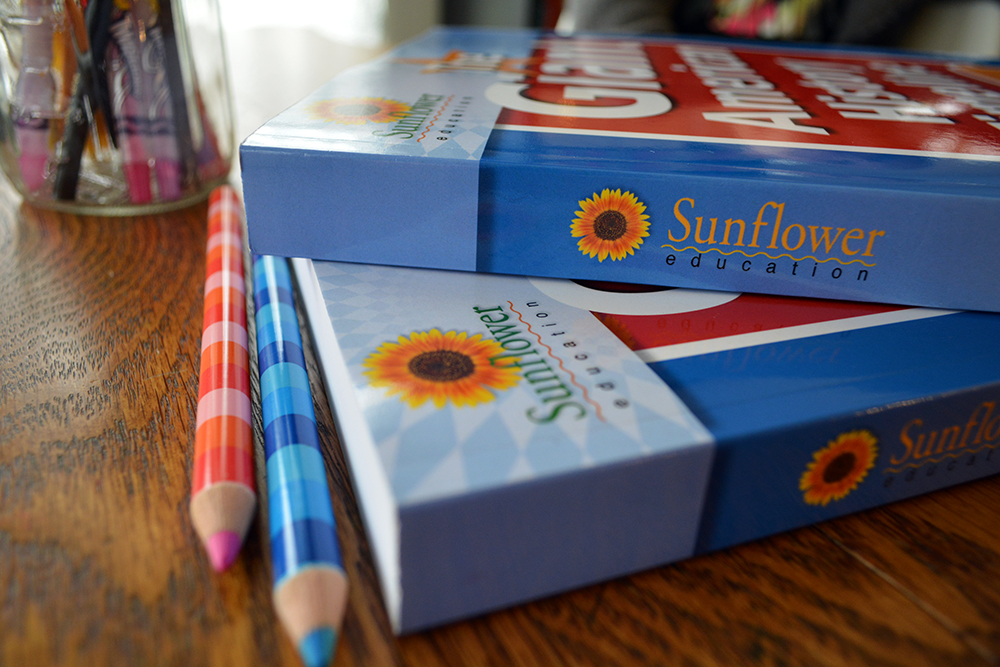


I love this idea! I know we are doing American History next year, but I have been struggling to find a curriculum that addresses the complexities of our history and doesn’t paint us as “God’s chosen people.” (I teach sociology at the college level so I am forever teaching about how institutions are broken because people are broken.) This looks like a great way to introduce our history, and (bonus!) even the more expensive printed version is more than $50 cheaper than what I thought we might use. (It did address such complexities but also had a tendency to shoehorn in Bible verses taken out of context which irritated my husband.) My daughter loves anything “unit-study” (v. Charlotte Mason), and I think this leans in that direction. Thanks for the info.
LikeLike
When printing two timelines on a page did you do this from the physical book or the digital version? Scratching my head on how you did this. Any help you could give me would be great. Thank you! Fascinating article!
LikeLike
Abby, I printed from the digital e-book PDF version :)
LikeLike